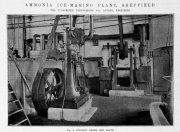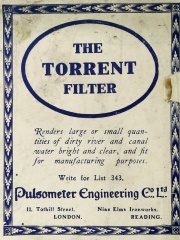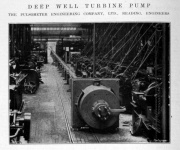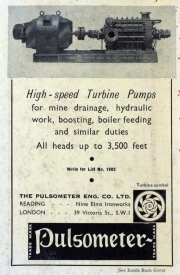Difference between revisions of "Pulsometer Engineering Co"
| (28 intermediate revisions by 7 users not shown) | |||
| Line 5: | Line 5: | ||
In Cornwall.]] | In Cornwall.]] | ||
[[Image:Matlock02.jpg|thumb| Large direct-acting underground steam pump recovered from Putwell Hill Mine, Monsal Dale, and now at the [[Peak District Mining Museum]]]] | [[Image:Matlock02.jpg|thumb| Large direct-acting underground steam pump recovered from Putwell Hill Mine, Monsal Dale, and now at the [[Peak District Mining Museum]]]] | ||
[[image:Im1877ev24-p501.jpg|thumb| 1877.]] | |||
[[image:Im1879Ev28-p413.jpg|thumb|1879.]] | |||
[[Image:Im18800102E-Pulsometer.jpg|thumb| January 1880. ]] | [[Image:Im18800102E-Pulsometer.jpg|thumb| January 1880. ]] | ||
[[Image:Im1880EnV50-p072.jpg|thumb| 1880. ]] | [[Image:Im1880EnV50-p072.jpg|thumb| 1880. ]] | ||
| Line 12: | Line 14: | ||
[[image:Im1887V63-p468a.jpg|thumb| 1887. Portable pulsometer and boiler.]] | [[image:Im1887V63-p468a.jpg|thumb| 1887. Portable pulsometer and boiler.]] | ||
[[image:Im18880106E-Puls.jpg|thumb| January 1888.]] | [[image:Im18880106E-Puls.jpg|thumb| January 1888.]] | ||
[[Image:Im18880316PE-Pulse.jpg|thumb| March 1888. ]] | |||
[[image:Im18880629E-Puls.jpg|thumb| June 1888. Steam pump. ]] | [[image:Im18880629E-Puls.jpg|thumb| June 1888. Steam pump. ]] | ||
[[image:Im1888EnV65-p463a.jpg|thumb| 1888.]] | [[image:Im1888EnV65-p463a.jpg|thumb| 1888.]] | ||
[[Image: | [[Image:Im18891213Eng-Pulsometer.jpg|thumb| December 1889. ]] | ||
[[image:Im1889EnV67-p77.jpg|thumb| 1889. Pupletts Ammonia Ice-Making Machine.]] | [[image:Im1889EnV67-p77.jpg|thumb| 1889. Pupletts Ammonia Ice-Making Machine.]] | ||
[[Image:Championice.jpg|thumb|right| 1890. ]] | [[Image:Championice.jpg|thumb|right| 1890. ]] | ||
[[Image:Im1892EnV73-p152.jpg|thumb| 1892. ]] | [[Image:Im1892EnV73-p152.jpg|thumb| 1892. ]] | ||
| Line 23: | Line 27: | ||
[[Image:Im1896EnV81-p517.jpg|thumb| 1896. ]] | [[Image:Im1896EnV81-p517.jpg|thumb| 1896. ]] | ||
[[Image:Im1897EnV84-p340.jpg|thumb| 1897. ]] | [[Image:Im1897EnV84-p340.jpg|thumb| 1897. ]] | ||
[[Image:Im1898EYB-Pulse.jpg |thumb| 1898. ]] | |||
[[image:Im189806Cass-Pulsometer.jpg|thumb| June 1898. ]] | [[image:Im189806Cass-Pulsometer.jpg|thumb| June 1898. ]] | ||
[[Image:Im189908Cass-Puls.jpg |thumb| August 1899. ]] | [[Image:Im189908Cass-Puls.jpg |thumb| August 1899. ]] | ||
[[Image:Im1899MWYB-Pulsometer.jpg|thumb| 1899. ]] | [[Image:Im1899MWYB-Pulsometer.jpg|thumb| 1899. ]] | ||
[[Image:Im1899MWYB-Pulsometer2.jpg|thumb| 1899. ]] | [[Image:Im1899MWYB-Pulsometer2.jpg|thumb| 1899. ]] | ||
[[Image:Im1899PEYB-Pulse.jpg|thumb|1899. ]] | |||
[[Image:Im1900MWYB-Pulse1.jpg|thumb| 1900. ]] | |||
[[Image:Im1900MWYB-Pulse2.jpg|thumb| 1900. ]] | |||
[[Image:Im190102Cass-Puls.jpg|thumb| February 1901. ]] | |||
[[Image:Im190102Cass-Pulse.jpg|thumb| February 1901. ]] | |||
[[Image:Im1902Cass-Pulse.jpg|thumb| 1902. ]] | |||
[[Image:Im190201Cass-Pulse.jpg|thumb| January 1902. ]] | |||
[[Image:Im190209Pages-Pulsometer.jpg|thumb| September 1902. ]] | [[Image:Im190209Pages-Pulsometer.jpg|thumb| September 1902. ]] | ||
[[Image:Im1903PEYB-Pulse.jpg|thumb| 1903. ]] | |||
[[Image:Im19030303JGL-Puls.jpg|thumb| March 1903.]] | [[Image:Im19030303JGL-Puls.jpg|thumb| March 1903.]] | ||
[[Image:Im1905MWYB-Pulsometer1.jpg|thumb|1905. ]] | [[Image:Im1905MWYB-Pulsometer1.jpg|thumb|1905. ]] | ||
| Line 39: | Line 53: | ||
[[Image:ImV103-p642hb.jpg |thumb| Karoome Pump. 1907. ]] | [[Image:ImV103-p642hb.jpg |thumb| Karoome Pump. 1907. ]] | ||
[[Image:ImV103-p642hha.jpg |thumb| Refrigerating Plant. 1907. ]] | [[Image:ImV103-p642hha.jpg |thumb| Refrigerating Plant. 1907. ]] | ||
[[Image:Im190903EC-Pulse.jpg|thumb| March 1909. ]] | |||
[[Image:Im19090907JGL-Puls.jpg|thumb| September 1909.]] | [[Image:Im19090907JGL-Puls.jpg|thumb| September 1909.]] | ||
[[image:Im19101213JGL-Pulsom.jpg|thumb| December 1910.]] | [[image:Im19101213JGL-Pulsom.jpg|thumb| December 1910.]] | ||
[[Image:Im19110124JGL-Pulsom.jpg|thumb| January 1911.]] | [[Image:Im19110124JGL-Pulsom.jpg|thumb| January 1911.]] | ||
[[Image:Im191203EC-Pulse.jpg|thumb| March 1912. ]] | |||
[[Image:Im191210PU-Pulse.jpg|thumb| October 1912. ]] | |||
[[Image:Im19130218JGL-Pulsom.jpg|thumb| February 1913.]] | [[Image:Im19130218JGL-Pulsom.jpg|thumb| February 1913.]] | ||
[[Image:Im191302PU-Pulse.jpg|thumb| February 1913. ]] | |||
[[Image:Im19130415JGL-Puls.jpg|thumb| April 1913.]] | [[Image:Im19130415JGL-Puls.jpg|thumb| April 1913.]] | ||
[[Image:Im1913MWYB-Pulse1.jpg|thumb| 1913. ]] | [[Image:Im1913MWYB-Pulse1.jpg|thumb| 1913. ]] | ||
| Line 51: | Line 70: | ||
[[Image:Im1919EnV127-p130a.jpg|thumb| 1919. ]] | [[Image:Im1919EnV127-p130a.jpg|thumb| 1919. ]] | ||
[[Image:Im1919EnV127-p130c.jpg|thumb| 1919. ]] | [[Image:Im1919EnV127-p130c.jpg|thumb| 1919. ]] | ||
[[Image:Im1921EnV131-p112bb.jpg|thumb| 1921. ]] | [[Image:Im1921EnV131-p112bb.jpg|thumb| 1921. ]] | ||
[[Image:Im1921EnV131-p338bb.jpg|thumb| 1921. ]] | [[Image:Im1921EnV131-p338bb.jpg|thumb| 1921. ]] | ||
[[image:Im1921EnV131-p448bb.jpg|thumb| 1921. ]] | [[image:Im1921EnV131-p448bb.jpg|thumb| 1921. ]] | ||
[[image:Im1921EnV131-p558aab.jpg|thumb| 1921. ]] | [[image:Im1921EnV131-p558aab.jpg|thumb| 1921. ]] | ||
[[Image:Im1923MWYB-Pulse.jpg|thumb| 1923.]] | |||
[[Image:Im1923MWYB-Pulse2.jpg|thumb| 1923.]] | |||
[[Image:Im1926EYB-Pulse.jpg|thumb| 1926. ]] | |||
[[Image:Im1926PR-PE.jpg |thumb| 1926. ]] | [[Image:Im1926PR-PE.jpg |thumb| 1926. ]] | ||
[[Image:Im1927v143-p222.jpg |thumb|1927.Deep Well Turbine Pump. ]] | [[Image:Im1927v143-p222.jpg |thumb|1927. Deep Well Turbine Pump. ]] | ||
[[Image:Im19291206Eng-Pulse.jpg|thumb| December 1929. ]] | |||
[[image:Im1930v150-p89.jpg|thumb| 1930. Alfred Street hydraulic pumping station, Hull.]] | [[image:Im1930v150-p89.jpg|thumb| 1930. Alfred Street hydraulic pumping station, Hull.]] | ||
[[Image:Im1931PR-Pulse.jpg|thumb| 1931. ]] | |||
[[Image:Im1931v152-p282ka.jpg |thumb|1931. 5in. Marine Pump.]] | |||
[[image:Im1936MWHB-Pulse.jpg|thumb| 1936. ]] | [[image:Im1936MWHB-Pulse.jpg|thumb| 1936. ]] | ||
[[image:Im1936MWHB-Pulse2.jpg|thumb| 1936. ]] | [[image:Im1936MWHB-Pulse2.jpg|thumb| 1936. ]] | ||
| Line 64: | Line 91: | ||
[[Image:Im194603BTJ-Pulsometer.jpg|thumb| March 1946. ]] | [[Image:Im194603BTJ-Pulsometer.jpg|thumb| March 1946. ]] | ||
[[Image:Im194603BTJ-Pulsometer2.jpg|thumb| March 1946. ]] | [[Image:Im194603BTJ-Pulsometer2.jpg|thumb| March 1946. ]] | ||
[[Image:Im1951MWYB-Pulse.jpg|thumb| 1951. ]] | |||
[[Image:Im1951MWYB-Pulse2.jpg|thumb| 1951. ]] | |||
[[image:Im195210HVE-Pulsometer.jpg |thumb| October 1952.]] | |||
[[Image:Im1960MWYB-Pulso1.jpg|thumb| 1960. ]] | [[Image:Im1960MWYB-Pulso1.jpg|thumb| 1960. ]] | ||
[[Image:Im1960MWYB-Pulso2.jpg|thumb| 1960. ]] | [[Image:Im1960MWYB-Pulso2.jpg|thumb| 1960. ]] | ||
| Line 72: | Line 103: | ||
[[image:Im20110723SW-Pulse.jpg|thumb| ]] | [[image:Im20110723SW-Pulse.jpg|thumb| ]] | ||
of Nine Elms Iron Works, Reading | of Battersea and later Nine Elms Iron Works, London, and Reading. | ||
1872 The Pulsometer steam pump, a piston-less pump, was invented by American Thomas Hall. The invention may have been inspired by the Savery steam pump invented by Thomas Savery. Around the turn of the century, it was a popular and | 1872 The Pulsometer steam pump, a piston-less pump, was invented by American Thomas Hall. The invention may have been inspired by the Savery steam pump invented by Thomas Savery. Around the turn of the century, it was a popular and effective pump for quarry pumping. | ||
1875 [[John Eliot Hodgkin]], a British engineer bought the patent rights of the Pulsometer and it was introduced to the market soon thereafter. This extremely simple pump was made of cast iron, and had no pistons, rods, cylinders, cranks, or flywheels. It operated by the direct action of steam on water. The mechanism consisted of two chambers. As the steam condensed in one chamber, it acted as a suction pump, while in the other chamber, steam was introduced under pressure and so it acted as a force pump. At the end of every stroke, a ball valve consisting of a small rubber ball moved slightly, causing the two chambers to swap functions from suction-pump to force-pump and vice versa. The result was that the water was first suction pumped and then force pumped. | 1875 [[John Eliot Hodgkin]], a British engineer bought the patent rights of the Pulsometer and it was introduced to the market soon thereafter. This extremely simple pump was made of cast iron, and had no pistons, rods, cylinders, cranks, or flywheels. It operated by the direct action of steam on water. The mechanism consisted of two chambers. As the steam condensed in one chamber, it acted as a suction pump, while in the other chamber, steam was introduced under pressure and so it acted as a force pump. At the end of every stroke, a ball valve consisting of a small rubber ball moved slightly, causing the two chambers to swap functions from suction-pump to force-pump and vice versa. The result was that the water was first suction pumped and then force pumped. | ||
| Line 80: | Line 111: | ||
The pump ran automatically without attendance. It was praised for its "extreme simplicity of construction, operation, compact form, high efficiency, economy, durability, and adaptability". Later designs were improved upon to enhance efficiency and to make the machine more accessible for inspection and repairs, thus reducing maintenance costs. | The pump ran automatically without attendance. It was praised for its "extreme simplicity of construction, operation, compact form, high efficiency, economy, durability, and adaptability". Later designs were improved upon to enhance efficiency and to make the machine more accessible for inspection and repairs, thus reducing maintenance costs. | ||
1876 See [[Hodgkin, | 1876 See [[Hodgkin, Neuhaus and Co]]. | ||
1878 Public company. The company was formed as '''The Pulsometer Engineering Company Ltd'''. The pump range was continually expanded and it was as a pump manufacturer that the Company became best known. | 1878 Public company. The company was formed as '''The Pulsometer Engineering Company Ltd'''. The pump range was continually expanded and it was as a pump manufacturer that the Company became best known. | ||
With this increase in product range and trade all over the world, a larger factory was found and set up in Battersea, London. | With this increase in product range and trade all over the world, a larger factory was found and set up in Battersea, London. | ||
c.1887 The Pulsometer Engineering Co bought the patents of [[Frederick Hale Holmes]] and took on [[Charles Ingrey]], formerly of the [[Caloric Engine and Siren Fog-Signal Co]] as their senior engineer. <ref>'Lost Sounds' by Alan Renton, Whittles Publishing, 2001</ref> | |||
1888 The 'Torrent' Filter for dealing with large quantities of water in the manufacturing process. <ref>[[The Engineer 1888/06/01]] p463</ref> | 1888 The 'Torrent' Filter for dealing with large quantities of water in the manufacturing process. <ref>[[The Engineer 1888/06/01]] p463</ref> | ||
| Line 90: | Line 123: | ||
1889 Ammonia Ice-making machine. <ref>[[The Engineer 1889/01/25]] p77</ref> | 1889 Ammonia Ice-making machine. <ref>[[The Engineer 1889/01/25]] p77</ref> | ||
1889 Deane pump shown at the RASE at Windsor. <ref>[[The Engineer 1889/06/28]] p546</ref> | 1889 [[Deane Steam Pump Co|Deane]] pump shown at the RASE at Windsor. <ref>[[The Engineer 1889/06/28]] p546</ref> | ||
1890 Advert on this page for "Champion" Hand Ice Machine. <ref>[http://www.historyworld.co.uk/index.php] History World</ref> | 1890 Advert on this page for "Champion" Hand Ice Machine. <ref>[http://www.historyworld.co.uk/index.php] History World</ref> | ||
| Line 102: | Line 135: | ||
1905 Advert for steam pump and as feed water specialists. <ref>Mechanical World Year Book 1905. Published by Emmott and Co of Manchester. Advert on two inside covers</ref> | 1905 Advert for steam pump and as feed water specialists. <ref>Mechanical World Year Book 1905. Published by Emmott and Co of Manchester. Advert on two inside covers</ref> | ||
1908 Bought [[Easton, Anderson and Goolden]] | 1908 Bought [[Easton, Anderson and Goolden]]/[[Easton and Co]] | ||
1913 Advert for steam pumps, centrifugal and turbine pumps, refrigeration and filtration. <ref>Mechanical World Year Book 1913. Published by Emmott and Co of Manchester. Advert on two inside covers</ref> | 1913 Advert for steam pumps, centrifugal and turbine pumps, refrigeration and filtration. <ref>Mechanical World Year Book 1913. Published by Emmott and Co of Manchester. Advert on two inside covers</ref> | ||
| Line 121: | Line 154: | ||
1945 Advert for centrifugal and turbine pumps. <ref>Mechanical World Year Book 1945. Published by Emmott and Co of Manchester. Advert on two inside covers</ref> | 1945 Advert for centrifugal and turbine pumps. <ref>Mechanical World Year Book 1945. Published by Emmott and Co of Manchester. Advert on two inside covers</ref> | ||
1951 Acquired [[Joseph Evans and Sons]]<ref>The Times, 25 June 1956</ref>. | 1951 Acquired [[Joseph Evans and Sons]]<ref>The Times, 25 June 1956</ref>. | ||
| Line 136: | Line 167: | ||
1960 Advert for centrifugal, turbine, reciprocating and high-vacuum pumps.<ref>Mechanical World Year Book 1960. Published by Emmott and Co of Manchester. Advert on two inside covers</ref> | 1960 Advert for centrifugal, turbine, reciprocating and high-vacuum pumps.<ref>Mechanical World Year Book 1960. Published by Emmott and Co of Manchester. Advert on two inside covers</ref> | ||
1961 Pulsometer had maintained its reputation for products of exceptionally high quality and reliability for 60 years. Pulsometer Engineering | 1961 Pulsometer had maintained its reputation for products of exceptionally high quality and reliability for 60 years. Pulsometer Engineering Co was acquired jointly by [[Booker McConnell|Booker McConnell Group]] and [[G. and J. Weir Holdings]]; each purchaser took the parts of the company that they wanted<ref>The Times, Jun 12, 1962</ref>. Booker already owned another pump company, [[Sigmund Pumps]] of Gateshead; together with Pulsometer this created one of the largest pump companies in Europe which became known as [[Sigmund Pulsometer Pumps]], or '''SPP''' for short. | ||
1961 Manufacturers of centrifugal, reciprocating, rotary and high vacuum pumps. 1,000 employees. <ref>[[1961 Dun and Bradstreet KBE]]</ref> | 1961 Manufacturers of centrifugal, reciprocating, rotary and high vacuum pumps. 1,000 employees. <ref>[[1961 Dun and Bradstreet KBE]]</ref> | ||
Revision as of 12:41, 26 April 2020






of Battersea and later Nine Elms Iron Works, London, and Reading.
1872 The Pulsometer steam pump, a piston-less pump, was invented by American Thomas Hall. The invention may have been inspired by the Savery steam pump invented by Thomas Savery. Around the turn of the century, it was a popular and effective pump for quarry pumping.
1875 John Eliot Hodgkin, a British engineer bought the patent rights of the Pulsometer and it was introduced to the market soon thereafter. This extremely simple pump was made of cast iron, and had no pistons, rods, cylinders, cranks, or flywheels. It operated by the direct action of steam on water. The mechanism consisted of two chambers. As the steam condensed in one chamber, it acted as a suction pump, while in the other chamber, steam was introduced under pressure and so it acted as a force pump. At the end of every stroke, a ball valve consisting of a small rubber ball moved slightly, causing the two chambers to swap functions from suction-pump to force-pump and vice versa. The result was that the water was first suction pumped and then force pumped.
The pump ran automatically without attendance. It was praised for its "extreme simplicity of construction, operation, compact form, high efficiency, economy, durability, and adaptability". Later designs were improved upon to enhance efficiency and to make the machine more accessible for inspection and repairs, thus reducing maintenance costs.
1876 See Hodgkin, Neuhaus and Co.
1878 Public company. The company was formed as The Pulsometer Engineering Company Ltd. The pump range was continually expanded and it was as a pump manufacturer that the Company became best known.
With this increase in product range and trade all over the world, a larger factory was found and set up in Battersea, London.
c.1887 The Pulsometer Engineering Co bought the patents of Frederick Hale Holmes and took on Charles Ingrey, formerly of the Caloric Engine and Siren Fog-Signal Co as their senior engineer. [1]
1888 The 'Torrent' Filter for dealing with large quantities of water in the manufacturing process. [2]
1889 Ammonia Ice-making machine. [3]
1889 Deane pump shown at the RASE at Windsor. [4]
1890 Advert on this page for "Champion" Hand Ice Machine. [5]
1895 Advert for filters and pumps. [6]
1899 Advert for filers and a steam pump. [7]
1901 The Company moved from London to new premises at a site in Reading, UK. By now Pulsometer was a name well established and respected across the world as a leading manufacturer of pump equipment.
1905 Advert for steam pump and as feed water specialists. [8]
1908 Bought Easton, Anderson and Goolden/Easton and Co
1913 Advert for steam pumps, centrifugal and turbine pumps, refrigeration and filtration. [9]
1914 Engine for the West Gloucestershire Water Company (California Station).
1914 See 1914 Catalogue
1914 Listed specialities: the Pulsometer steam pump, direct-acting pumps, centrifugal and turbine pumps, ice-making and refrigerating machinery, water purification plants, installation of complete water work, sewage and drainage pumping. [10]
1917 Advert for steam pump for lifts up to 150 feet and centrifugal and turbine pumps. [11]
1919 Advert for steam pump for lifts up to 150 feet and centrifugal and turbine pumps. [12]
1927 Advert for steam pump for lifts up to 150 feet and centrifugal and turbine pumps. [13]
1940 Advert for centrifugal and turbine pumps. [14]
1945 Advert for centrifugal and turbine pumps. [15]
1951 Acquired Joseph Evans and Sons[16].
1956 Was part of the Camp Bird group[17]. Some shares owned by Dresser Industries, owners of Pacific Pumps with which Pulsometer had an arrangement to market their pumps. Other shares would be sold to enable others to own some of the company[18].
1957 Sold by Camp Bird to merchant bank Philip Hill, Higginson and Co[19]
1957 Acquired Skyhi and SPE[20]
1957 Acquired G S Tett and Co, maker of water softeners[21]
1960 Advert for centrifugal, turbine, reciprocating and high-vacuum pumps.[22]
1961 Pulsometer had maintained its reputation for products of exceptionally high quality and reliability for 60 years. Pulsometer Engineering Co was acquired jointly by Booker McConnell Group and G. and J. Weir Holdings; each purchaser took the parts of the company that they wanted[23]. Booker already owned another pump company, Sigmund Pumps of Gateshead; together with Pulsometer this created one of the largest pump companies in Europe which became known as Sigmund Pulsometer Pumps, or SPP for short.
1961 Manufacturers of centrifugal, reciprocating, rotary and high vacuum pumps. 1,000 employees. [24]
1986 After a number of changes in subsequent years, SPP acquired Henry Sykes[25]. This acquisition further expanded the product range with the addition of vacuum assisted self-priming pumps. It was around this time that SPP moved its manufacturing site from Reading to a more modern facility in Coleford, in the West of England.
See Also
Sources of Information
- [2] Wikipedia
- [3] SPP Web Site
- The Steam Engine in Industry by George Watkins in two volumes. Moorland Publishing. 1978. ISBN 0-903485-65-6
- ↑ 'Lost Sounds' by Alan Renton, Whittles Publishing, 2001
- ↑ The Engineer 1888/06/01 p463
- ↑ The Engineer 1889/01/25 p77
- ↑ The Engineer 1889/06/28 p546
- ↑ [1] History World
- ↑ Mechanical World Year Book 1895. Published by Emmott and Co of Manchester. Advert on two inside covers
- ↑ Mechanical World Year Book 1899. Published by Emmott and Co of Manchester. Advert on two inside covers
- ↑ Mechanical World Year Book 1905. Published by Emmott and Co of Manchester. Advert on two inside covers
- ↑ Mechanical World Year Book 1913. Published by Emmott and Co of Manchester. Advert on two inside covers
- ↑ 1914 Whitakers Red Book
- ↑ Mechanical World Year Book 1917. Published by Emmott and Co of Manchester. Advert on two inside covers
- ↑ Mechanical World Year Book 1919. Published by Emmott and Co of Manchester. Advert on two inside covers
- ↑ Mechanical World Year Book 1927. Published by Emmott and Co of Manchester. Advert on two inside covers
- ↑ Mechanical World Year Book 1940. Published by Emmott and Co of Manchester. Advert on two inside covers
- ↑ Mechanical World Year Book 1945. Published by Emmott and Co of Manchester. Advert on two inside covers
- ↑ The Times, 25 June 1956
- ↑ The Times, 11 May 1956
- ↑ The Times, 25 June 1956
- ↑ The Times, 1 February 1957
- ↑ The Times, Apr 14, 1958
- ↑ The Times, May 22, 1958
- ↑ Mechanical World Year Book 1960. Published by Emmott and Co of Manchester. Advert on two inside covers
- ↑ The Times, Jun 12, 1962
- ↑ 1961 Dun and Bradstreet KBE
- ↑ The Times, September 05, 1986























































































